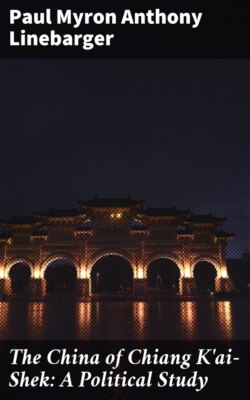Читать книгу The China of Chiang K'ai-Shek: A Political Study - Paul Myron Anthony Linebarger - Страница 8
На сайте Литреса книга снята с продажи.
The Chungking Period
ОглавлениеTable of Contents
The Chungking period began with the transfer of further government offices to the West, to join President Lin Shên, and marks a distinct phase in the process of government-building in China. As the Chungking regime, the National Government took new forms of temper and character. Government, Kuomintang, Communists—all were in the position of an inner-Asiatic state, without convenient access to the sea, seeking to fight an oceanic nation whose trade reached every port in the world. Foreign imperialism could no longer be blamed for the demoralizations of the hour; foreign aid was too tenuous and remote to qualify the inner play of Chinese political growth. Politically, the Chinese had to stand on their own feet.
The second phase of the war had begun. Chinese armies stood front-to-front against the Japanese, and kept hundreds of thousands of invading troops immobilized. The guerrillas got to work. Most of all, the machinery of modernization began functioning; all the programs had been completed, and the task was clear. The international developments of the time—the first American loan, $25,000,000 in 1938; the brief Manchoukuo-Outer Mongol war of 1939, wherein Japan and Russia fought each other through their respective dependencies; even the outbreak of the European war—were remote from this far inland scene. Military events had some effect, but nothing comparable to the Japanese victories at Shanghai, Nanking, Canton, and Hankow recurred. The Japanese invaded Kwangsi in the fall of 1939; they left a year later, when their drive into French Indo-China made it unnecessary to cut those colonies off from China. In South Hunan the Japanese suffered catastrophically when they advanced boldly and contemptuously into non-modern areas and were encircled by the Chinese. Even the flight and treason of Wang Ch'ing-wei at the year's end of 1938, and his open cooperation with Japan in March 1940, did not change the general picture. The emphasis was no longer on sudden changes, on personality, on dramatic shifts of power. It was on construction—on the development of a modern, democratic, technically equipped Chinese state out of the vast resources of China's hinterland. The China which was to win had to be created before it could counter-attack.[16]
